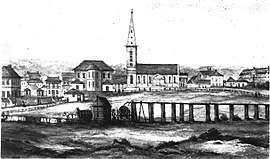Busby's Bore
 An 1857 sketch of the stand pipe in Hyde Park | |
| Overview | |
|---|---|
| Coordinates | 33°53′52″S 151°13′42″E / 33.897833°S 151.228376°E |
| Start | Lang Park |
| End | Hyde Park |
| Operation | |
| Work begun | September 1827 |
| Opened | June 1837 |
| Owner | Sydney Water |
| Technical | |
| Design engineer | John Busby |
| Length | 3.6 kilometres (2 1⁄4 mi) |
| Official name | Busby's Bore |
| Designated | 2 April 1999 |
| Reference no. | 00568 |
Busby's Bore was Sydney's second water supply. The heritage-listed bore was built by convict labour between 1827 and 1837.[1][2][3][4]
History
By the 1820s the Tank Stream, Sydney's original water supply, had become little more than an open sewer, and the growing colony had become reliant on wells or water carted from the Lachlan Swamps (now Centennial Park).
In 1826, John Busby recommended that water from the Lachlan Swamps be delivered to a reservoir at the Racecourse (now Hyde Park) via a tunnel (or 'bore'). The reservoir was not approved but construction of the tunnel began in September 1827.[5] The Bore was not completed until 1837[6] but began supplying drinkable water in 1830.
The Bore commenced at what is now Busby's Pond, close to the present Lang Road entrance to Centennial Park and ended in the present Hyde Park near the Oxford Street entrance - a total distance of 3.6 kilometres (2 1⁄4 mi). From there, a line of pipe supported on trestles extended to a point near the corner of Park and Elizabeth Streets.
The Bore was built by convict labour, mostly through solid sandstone. It averaged 1.5 metres (5 ft) high by 1.2 metres (4 ft) wide, though it varied from 0.9 metres (3 ft) by 0.9 metres (3 ft) to 3.4 metres (11 ft) high. The completed Bore delivered about 1.5 megalitres (53×103 cu ft) water per day. Not all went to plan as there were injuries.[7]
In 1833, pipes were laid to the Port to allow ships to be supplied. Starting in 1844, reticulation pipes were laid, allowing houses to be connected, as well as the establishment of a number of public fountains. In 1854, supply was supplemented with the installation of a small pumping station at the lower end of the swamp, as well as a number of small dams. In 1872, the Bore was cleaned and some irregularities removed, increasing the tunnel flow to about 4.5 megalitres (160×103 cu ft) per day.
Starting in 1859, Busby's Bore was supplemented and later supplanted by water pumped from Botany Swamps.[8] In 1934, part of the Bore under Oxford Street was filled with sand to remove the risk of subsidence under the tram lines.[9][10]
The Bore remains under the ownership of Sydney Water. It is listed on the New South Wales Heritage Register[1] and the former Register of the National Estate and is protected by a Permanent Conservation Order.[11]
Chronology
- 1827 Work started at Hyde Park
- 1830 First water from springs encountered
- 1833 Pipes from Hyde Park to supply shipping
- 1837 Tunnel completed: 1.5 to 1.8 megalitres (53×103 to 64×103 cu ft) per day to water carts
- 1844 General pipe reticulation
- 1872 Refurbishment and cleanout of tunnel: 6 megalitres (210×103 cu ft) per day
- 1890 Superseded by other schemes
- 1902 Botanic Gardens supply only
- 1934 Oxford Street section backfilled with sand
- 2004 Proposal to reactivate Bore to supply city parks and gardens
- 2006 NSW Government allocates funds for restoration of the Bore to supply parks of Sydney central business district.[12][13]
References
- 1 2 "Busby's Bore". New South Wales State Heritage Register. Office of Environment and Heritage.
- ↑ "Busby's Bore". New South Wales Heritage Database. Office of Environment and Heritage.
- ↑ "Busby's Bore". New South Wales Heritage Database. Office of Environment and Heritage.
- ↑ "Busby's Bore". New South Wales Heritage Database. Office of Environment and Heritage.
- ↑ "ADVANCE AUSTRALIA SYDNEY GAZETTE, AND New South Wales Advertiser". Sydney Gazette, and New South Wales Advertiser. XXV (1281). 10 January 1827. p. 2. Retrieved 15 April 2017 – via National Library of Australia.
"From the Steam Office,". Sydney Gazette, and New South Wales Advertiser. XXV, (1416). 24 October 1827. p. 2. Retrieved 15 April 2017 – via National Library of Australia.
"MISCHIEF OF ALTERING THE CIRCULATING MEDIUM". The Australian (466). 16 December 1829. p. 3. Retrieved 15 April 2017 – via National Library of Australia. - ↑ "Colonial Statistics". The Colonist. III, (150). New South Wales, Australia. 9 November 1837. p. 2. Retrieved 16 April 2017 – via National Library of Australia.
"TUNNEL". Sydney Gazette, and New South Wales Advertiser. XXXV (3038). 9 November 1837. p. 3. Retrieved 16 April 2017 – via National Library of Australia. - ↑ "Domestic Intelligence". The Sydney Monitor. V, (258). 27 March 1830. p. 2 (AFTERNOON). Retrieved 15 April 2017 – via National Library of Australia.
- ↑ "A Short History of the City of Botany Bay". Archived from the original on 3 January 2010. Retrieved 12 January 2010.
- ↑ Henry, F. J. J. (1939). The water supply and sewerage of Sydney (pdf). Metropolitan Water Sewerage and Drainage Board. pp. 45–47.
- ↑ "ANCIENT BORE". The Sun (7610). New South Wales, Australia. 23 May 1934. p. 19 (LAST RACE EDITION). Retrieved 17 April 2017 – via National Library of Australia.
- ↑ Aird, W. V. (1961), The Water Supply, Sewerage and Drainage of Sydney, Metropolitan Water Sewerage and Drainage Board
- ↑ "City uses Cross City Tunnel water to drought proof parks". Archived from the original on 16 July 2011.
- ↑ "Busby's Bore". Clean Up Australia.
Attribution
![]()
External links
- reference and article (CC-by-sa) on Busby's Bore in the Dictionary of Sydney
- Wooden pipe section display Powerhouse Museum